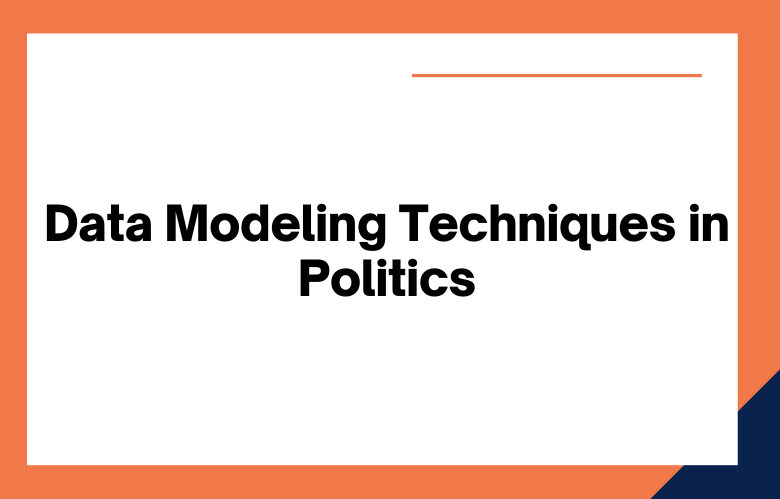Data modeling is a process that helps you understand and represent your data. With proper techniques, data modeling can drive positive political campaign outcomes. We will explore three data modeling techniques to help you succeed in your next political campaign. Stay tuned for tips to use these techniques effectively!
In politics, data is king. And to win, campaigns need to use data modeling techniques to drive the most impact.
By looking at past voting behaviors and trends, analyzing current poll results, and utilizing other data sources, campaigns can create targeted voter models that provide the most accurate predictions of who will vote and how they will vote.
This information can then strategically target voters with customized messages and get-out-the-vote efforts that will most likely result in victory on election day.
If you are interested in focusing your voice hear the political season, ensure you know what data modeling is and how it helps achieve your goals!
What is Data Modeling?
Data modeling is the process of designing a data model. A data model is a logical representation of data that shows the relationships between data and how those relationships answer questions. Data modeling can use to design or understand existing databases’ structures.
Data modeling is creating a model, or blueprint, of how data organizes. The model predicts how data uses and how it stores. Data modeling is a powerful tool that can help you make better decisions about your data.
Data modeling is creating a model of how data is structured and related. This model can better understand, organize, and store data. Data modeling can also improve communication between interested parties, such as developers and business users.
Data modeling is the process of designing and creating a model of data. This model can be used to understand better and manage data. Data modeling can help businesses and organizations know what data they have, how it organizes, and how it operates.
Data Modeling Techniques to Drive Political Campaign Impact
Some data modeling techniques can drive political campaign impact. For example, a media market analysis method can help identify which media markets are most important to a campaign. The information makes more informed decisions about where to spend money on advertising and how to target messages.
To effectively drive political campaign impact, data modeling techniques are essential. By analyzing past campaign data, numerical models help predicts voter behavior. It allows campaigns to target specific groups of voters with customized messages, increasing the chances of success in Elections.
Data modeling is a powerful tool used to shape political campaign outcomes. By understanding how data is collected and structured, campaign managers can make more informed decisions on allocating resources and targeting voters.
Targeting voters is one of the most important aspects of any political campaign. Using data modeling techniques, campaign managers can better understand their target audience and how to reach them best. It makes a big difference in the success of a campaign.
Data modeling can also predict the outcome of a campaign. It is done by analyzing past data and trends. By understanding how people have voted in the past, campaign managers can better predict how they will vote in the future. The information uses to adjust a campaign strategy to ensure victory.
Many data modeling techniques drive political campaign impact. Each method has pros and cons, so choosing the right one for your campaign is essential.
One data modeling technique that can drive political campaign impact is data mining. With data mining, you can collect and analyze vast amounts of data to find trends and patterns. It creates targeted messaging and strategies. However, data mining requires a lot of time and resources.
Another data modeling technique that can use is social media analysis. It involves analyzing social media platforms like Twitter and Facebook to see what people say about your campaign.
It gives you valuable insights into how people feel about your campaign and what issues are important to them. However, social media analysis can be time-consuming, and it can be challenging to obtain accurate data.
In political campaigns, data modeling techniques can create impactful messages that resonate with voters. By understanding the demographics of each voter and customizing messages accordingly, campaigns can effectively target their audience and deliver a winning note.
Several data modeling techniques assess the potential impact of a political campaign. For example, predictive modeling can identify which voters are most likely to respond positively to drive messaging.
Social network analysis can assess which voters are most influenced by their peers. And statistical techniques identify relationships between different factors and campaign outcomes. By understanding and utilizing these techniques, campaigns can more effectively target their resources and maximize their impact.
Numerous data modeling techniques drive political campaign impact. Cost analysis, regression analysis, and voting behavior analysis are examples.
By understanding the relationships between campaign costs and voter behavior, campaigns can more effectively allocate resources and make decisions that lead to victory on election day.
- Data modeling is a process of organizing data to best support the business or organizational goals.
- There are three basic steps in data modeling- understanding the business problem, designing the model, and creating the model.
- The most common data models are entity-relationship diagrams (ERDs), which show how entities (e.g., people and organizations) relate to each other.
- ERDs use rectangles to represent entities and diamonds to represent relationships.
- Attributes (properties) of entities can show as text inside boxes attached to the entity rectangle.
- Cardinality (the number of times an entity occurs in a relationship) is indicated by the crow’s feet on the diamond.
- Many software tools are available for creating ERDs, including Microsoft Visio and Erwin.
- Understand the different types of data models and when to use them
- Develop a data model that can support your campaign strategy
- Use data profiling techniques to understand your voter base
- Identify trends in voting behavior and target key demographics
- Analyze past election results to predict future outcomes
- Prepare for Election Day by tracking voting patterns and expecting a turnout
- Evaluate the success of your campaign and make necessary adjustments
- Data modeling is the process of organizing data to best support analytical needs
- There are a variety of data modeling techniques that can be used, depending on the situation
- The most common data modeling technique is the Entity-Relationship model
- The Entity-Relationship model divides data into entities and relationships between them
- Other popular data modeling techniques include the hierarchical model, network model, and object-oriented model
- Each method has its strengths and weaknesses, so it’s essential to choose the right one for the job
- Using the correct data modeling technique ensures that your political campaign has maximum impact.
Conclusion
Data modeling is a powerful tool to help campaigns understand and target specific voters. It can identify key voting blocs, predict turnout, and allocate resources most effectively.
If you are interested to learn if data modeling helps your campaign or would like us to perform a modeling analysis for you, please get in touch.
We are happy to discuss the needs and help to achieve success on election day.











